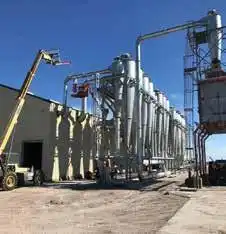
2 minute read
Getting To The Root Of The Problem
from Issue 45 of AG MAG
by THEAGMAG
Not all evidence of a plant pathogen can be seen above the surface. Phytophthora root rot caused by Phytophthora sp. is the most common cause of root rot. This rot of the root system hinders the ability of the host plant to take up water and nutrients. Below the surface, it can be observed as discoloration and decay of the roots. Phytophthora has a cell wall made of cellulose and is classified as an oomycete, also known as a water mold. Oomycetes are capable of producing self-motile spores called zoospores. These spores have flagella that allow them to swim. A cool and wet climate allows for excessive water is a conducive environment for a Phytophthora infection. However, any excessive amount of water can create an environment for Phytophthora spores to move and infect plant tissue. With motile spores and a broad host range, Phytophthora causes a great amount of plant and subsequently economic damage worldwide.
Symptoms of Phytophthora are often generalized. Many symptoms can appear similar to drought symptoms because of the host’s inability to take up water and nutrients. Mild root rot symptoms caused by the pathogen can be seen as abnormal foliage growth. A more severe case of root rot that prevents new shoot development and promotes death can cause a host plant to wilt, stunt, and can even cause premature death. A host will also show yellowing, chlorosis, and necrosis of foliage due to the lack of nutrients and water.
Advertisement
As mentioned previously, excessive amounts of water create a conducive environment for Phytophthora. Fungicides can reduce severity, but chemical control will not completely eradicate the pathogen. Due to this, drainage is a key practice to manage. Proper drainage management and other cultural practices can prevent and help eradicate Phytophthora if an infection does take place. There are a few cultural practices that have been proven to be the most beneficial when preventing Phytophthora. These practices include using plants that have disease resistance, increasing spacing between plants, proper sterilization of equipment and containers between plants, and appropriate mulching around plants to prevent foliage contact with spores. As well as avoiding contaminated land. These practices allow a grower to have the most control over a Phytophthora infection.
WE BUILD, SERVICE AND REMODEL ALL TYPES OF AGRICULTURAL FACILITIES

• Grain Storage & Handling • Feed Mills – Remodel or New • Feed Lot Feeding & Grain Equipment • Hopper Tanks • Chain Conveyors • Grain Probes • Belt Conveyors • Bucket Elevators • Catwalks & Towers • Truck Scales • Grain Vacs



130’ Conveyor Installation Cotton Gin Cyclone Installation New Elevator Installation











